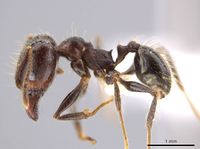Pheidole guerrerana
| Pheidole guerrerana | |
|---|---|

| |
| Scientific classification | |
| Kingdom: | Animalia |
| Phylum: | Arthropoda |
| Class: | Insecta |
| Order: | Hymenoptera |
| Family: | Formicidae |
| Subfamily: | Myrmicinae |
| Tribe: | Attini |
| Genus: | Pheidole |
| Species: | P. guerrerana |
| Binomial name | |
| Pheidole guerrerana Wilson, 2003 | |
The nest of the type colony was beneath a rock in a forest clearing. A winged queen was present on 31 July. (Wilson 2003)
Identification
See the description in the nomenclature section.
Keys including this Species
Distribution
Only known from the type locality.
Latitudinal Distribution Pattern
Latitudinal Range: 22.673° to 13.98306°.
| North Temperate |
North Subtropical |
Tropical | South Subtropical |
South Temperate |
- Source: AntMaps
Distribution based on Regional Taxon Lists
Neotropical Region: Guatemala, Honduras, Mexico (type locality), Nicaragua.
Distribution based on AntMaps
Distribution based on AntWeb specimens
Check data from AntWeb
Countries Occupied
| Number of countries occupied by this species based on AntWiki Regional Taxon Lists. In general, fewer countries occupied indicates a narrower range, while more countries indicates a more widespread species. |

|
Estimated Abundance
| Relative abundance based on number of AntMaps records per species (this species within the purple bar). Fewer records (to the left) indicates a less abundant/encountered species while more records (to the right) indicates more abundant/encountered species. |

|
Biology
Castes
Worker
Minor
Images from AntWeb
   
| |
| Worker. Specimen code casent0629401. Photographer M. Pierce, uploaded by University of Utah. | Owned by JTLC. |
Nomenclature
The following information is derived from Barry Bolton's Online Catalogue of the Ants of the World.
- guerrerana. Pheidole guerrerana Wilson, 2003: 156, figs. (s.w.) MEXICO.
Unless otherwise noted the text for the remainder of this section is reported from the publication that includes the original description.
Description
A member of the crassicornis group distinguished by the following combination of traits.
Major: rugoreticulum mesad to the eyes very extensive, reaching from near the posterior clypeal border to midway between the eye and occiput; pilosity very dense and long, especially on the dorsal surfaces of the head and on the gastral tergites; anterior strip of pronotal dorsum transversely carinulate; postpetiole from above diamond-shaped.
Minor: pilosity extremely long over most of the body; humerus subangulate in dorsal-oblique view; occiput narrowed, with rudiment of a nuchal collar.
MEASUREMENTS (mm) Holotype major: HW 1.28, HL 1.42, SL 1.02, EL 0.24, PW 0.66. Paratype minor: HW 0.58, HL 0.74, SL 0.94, EL 0.20, PW 0.42.
COLOR Major: head indistinctly bicolorous, with capsule anterior to eye level yellow and remainder yellowish brown; mesosoma and appendages yellowish brown; waist and gaster plain light brown.
Minor: indistinctly bicolorous, with head capsule posterior to anterior margin of eye as well as gaster and postpetiolar dorsum light brown; remainder of body dark yellow to brownish yellow.
Figure. Upper: holotype, major. Lower: paratype, minor. Scale bars = 1 mm.
Type Material
MEXICO: at road 3.5 km below Omilteme, Guerrero, 2000 m (Cornell University Field Party). Museum of Comparative Zoology
Etymology
Named after the Mexican state of origin.
References
- Wilson, E. O. 2003. Pheidole in the New World: A dominant, hyperdiverse ant genus. Harvard University Press, Cambridge, MA. (page 156, fig. major, minor described)
References based on Global Ant Biodiversity Informatics
- Dattilo W. et al. 2019. MEXICO ANTS: incidence and abundance along the Nearctic-Neotropical interface. Ecology https://doi.org/10.1002/ecy.2944
- Longino J. T. 2013. Ants of Nicargua. Consulted on 18 Jan 2013. https://sites.google.com/site/longinollama/reports/ants-of-nicaragua
- Longino J. T. L., and M. G. Branstetter. 2018. The truncated bell: an enigmatic but pervasive elevational diversity pattern in Middle American ants. Ecography 41: 1-12.
- Vásquez-Bolaños M. 2011. Lista de especies de hormigas (Hymenoptera: Formicidae) para México. Dugesiana 18: 95-133
- Wilson, E.O. 2003. Pheidole in the New World: A Dominant, Hyperdiverse Genus. Harvard University Press


